|
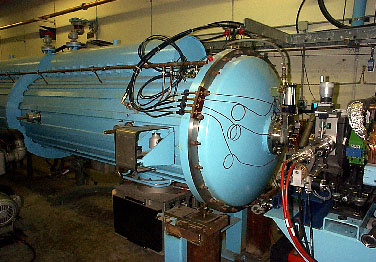 Fermilab's Linac, LINear ACcelerator, is composed of two different types of accelerating components: drift tubes and side-coupled cavities. There are five drift tube cavities and seven side coupled cavities in Linac. The drift tube Linac makes up the first stage of the Linac and the side-coupled Linac is the second stage. The Linac takes the 750 keV H- ions from the Preaccelerator, accelerates them to 400 MeV, and then sends them on to the Booster.
Fermilab's Linac, LINear ACcelerator, is composed of two different types of accelerating components: drift tubes and side-coupled cavities. There are five drift tube cavities and seven side coupled cavities in Linac. The drift tube Linac makes up the first stage of the Linac and the side-coupled Linac is the second stage. The Linac takes the 750 keV H- ions from the Preaccelerator, accelerates them to 400 MeV, and then sends them on to the Booster.
The Drift Tube Linac
Fermi's original Linac, made entirely of drift tubes, was based on the Linear accelerator built by Luis Alvarez at Berkeley in 1947. Alvarez designed the first proton linear accelerator at the University of California at Berkeley where he was a Professor of Physics.
The picture on the left shows a Fermi drift tube.
The drift tube is a cylindrical, electrically-resonant, water-cooled steel tank clad inside with OFHC (Oxygen Free, High Conductivity) copper. These Alvarez drift-tubes accelerate the beam from 750 keV to 116 MeV.
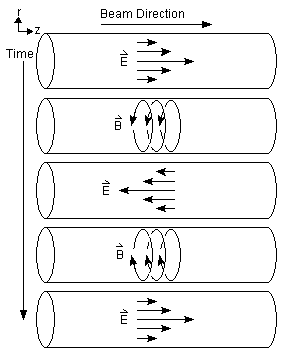 Drift-Tube Fields
Drift-Tube Fields
The figure on the right shows a simplified example of the magnetic field in a drift-tube.
The size of the electric field is the same along the length of each tank (except for tank one, which is special). In a sense, the magnetic field wraps around the inside edge of the tank. As the phase of the field changes, the direction of the accelerating force changes. The particle bunch has to be fed into the cavity at the correct time and then protected from the phase change while it remains in the drift tube. A quadrupole magnet, located in the center of the protecting cell, controls the bunch while the cell insulates the bunch from the field.
Accelerating Drift-Tube Cells
The interior of each drift-tube cavity actually consists of a number of resonant cells (you can see one of them in the cross-section drawing below); a cell runs from the middle of one drift tube to the middle of the next. The relative strengths of the electric fields in adjacent cells are controlled by the rotation of post couplers. These posts stick out from the cavity walls at the cell boundaries. A small tab on the end of the post coupler directs the electric field toward one cell or the other. The first drift-tube cavity, which is special, has no post couplers.
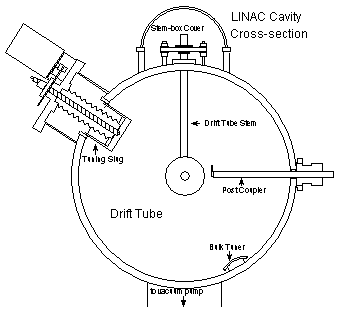 The length of the cells is such that particles travel the gap between drift tubes when the electric field is pointing in the accelerating direction. When the electric field is pointing in the opposite direction, the particles are shielded in the interior of the drift tubes, drifting in the absence of electric fields. The particles get a boost in energy and velocity with every gap crossed.
The length of the cells is such that particles travel the gap between drift tubes when the electric field is pointing in the accelerating direction. When the electric field is pointing in the opposite direction, the particles are shielded in the interior of the drift tubes, drifting in the absence of electric fields. The particles get a boost in energy and velocity with every gap crossed.
Linac RF Systems
The drift tube Linac has its own RF system that drives their appropriate cavity fields to the increased level and phase necessary for the particle to gain in energy. At specific times, the RF systems provide a short pulse for the acceleration of beam. In between the RF pulses the cavity field collapses. Each RF section consists of a low-level and high-level RF system. The low-level system provides a low power signal of the appropriate amplitude and phase for the drift tubes. This power is sent via a coaxial transmission line.
The cavity must resonate at the correct frequency and this requires a precise control of cavity volume. The active control of the cavity volume is through the tuning slug, this control works only if the temperature of the tank, as controlled by the water system, is constant to within a tenth of a degree Fahrenheit or so.
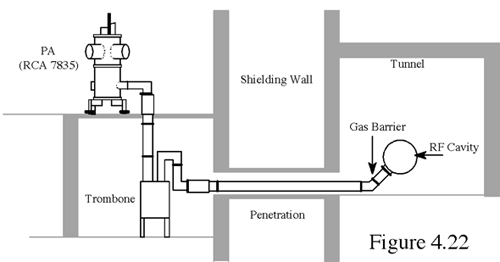
Drift Tube Linac Buncher
The beam pulse coming out of the source is dependent on the chop selected, but it isn't very efficient. Look at the picture on the left. The top line depicts the ribbon of beam as it comes out of the chopper.
The Buncher takes the selected ribbon of beam and stuffs the particles into 201.24 MHz bunches so that more of them will fit into the RF buckets.
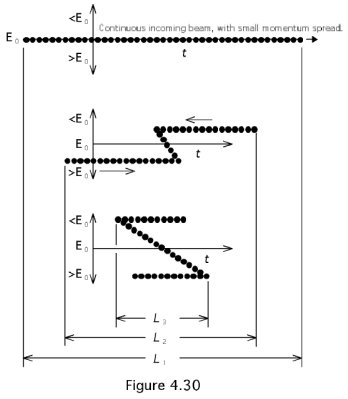 As you can see in the middle and bottom examples of the particle ribbon, the Buncher slows the particles arriving early in the RF cycle with a decelerating voltage, and those arriving later are sped up by an accelerating voltage, which creates a bunch.
As you can see in the middle and bottom examples of the particle ribbon, the Buncher slows the particles arriving early in the RF cycle with a decelerating voltage, and those arriving later are sped up by an accelerating voltage, which creates a bunch.
This bunch, along with others, is accelerated through the drift tubes and then sent on to the side-coupled cavities.
Water Systems
Conventional high-power electrical devices, like those found in the Linac, produce a good deal of waste heat. To keep components at operating temperatures many devices use cooling water that has been treated to reduce the number of free ions, which lower the conductivity. The LCW systems are treated, temperature-regulated, and pressurized at Fermi's Central Utility Building.
Three separate LCW systems system service the Linac: the 95º system, the 55º system, and the chilled water system.
- The 55º system provides cooling for the low energy Linac. The 55º system indirectly provides cooling (through heat exchangers) for the Preaccelerator power tubes, 750 keV trim and quadrupole magnets, RF stations, drift tube tank walls, Debuncher, and drift tube quadrupoles. These devices exchange heat with the 55º system to regulate temperatures, but do not draw or exchange water from the system except, on occasion, to top off water in their stand alone systems.
- The chilled water system supplies cooling for the high-energy Linac (the side-coupled cavities power by Klystrons).
- The 95º LCW system provides makeup for high energy Linac, the distribution skid, and the upper gallery RF station skids.
Each Linac system has its own heat exchanger, temperature regulator, pump, deionizer bottle, and reservoir.
Accelerator Update Archive
|  Fermilab's
Fermilab's  Drift-Tube Fields
Drift-Tube Fields The length of the cells is such that particles travel the gap between drift tubes when the electric field is pointing in the accelerating direction. When the electric field is pointing in the opposite direction, the particles are shielded in the interior of the drift tubes, drifting in the absence of electric fields. The particles get a boost in energy and velocity with every gap crossed.
The length of the cells is such that particles travel the gap between drift tubes when the electric field is pointing in the accelerating direction. When the electric field is pointing in the opposite direction, the particles are shielded in the interior of the drift tubes, drifting in the absence of electric fields. The particles get a boost in energy and velocity with every gap crossed.

 As you can see in the middle and bottom examples of the particle ribbon, the Buncher slows the particles arriving early in the RF cycle with a decelerating voltage, and those arriving later are sped up by an accelerating voltage, which creates a bunch.
As you can see in the middle and bottom examples of the particle ribbon, the Buncher slows the particles arriving early in the RF cycle with a decelerating voltage, and those arriving later are sped up by an accelerating voltage, which creates a bunch.